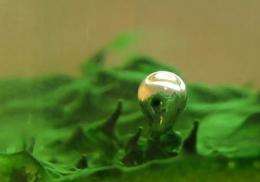Phosphorus identified as the missing link in evolution of animals

(�鶹��ԺOrg.com) -- A University of Alberta geomicrobiologist and his PhD student are part of a research team that has identified phosphorus as the mystery ingredient that pushed oxygen levels in the oceans high enough to establish the first animals on Earth.
The U of A’s Kurt Konhauser, student Stefan Lalonde and others re-examined established theories about the oxidation of the oceans in the wake of the last great glacier to encircle the planet.
Konhauser used one of his 2007 research papers, published in the journal Science, to focus the research team’s work on the mineral content within bands of iron found in rock layers of ancient seabeds.
“Theories published before 2007 said phosphorus was scarce throughout much of Earth’s history, but we found that that it was in fact plentiful,” said Konhauser.
The researchers say that during Earth’s most severe periods of glaciation, which occurred 750 to 580 million years ago, the planet was encircled with thick ice sheets.
“The key ingredient to the eventual oxidation of the oceans was found in the rubble of rock left behind when the glaciers receded,” said Lalonde. “We believe the glacial debris that washed into the oceans contained high concentrations of phosphorus.”
Phosphorus was essential to oxidation of the oceans, says Lalonde, because it sparked the growth of cyanobacteria, or blue-green-algae.
“The byproduct of blue-green-algae’s metabolic process is oxygen.”
“We’re not sure what the oxidation threshold level was,” says Konhauser, “but it finally reached a level favourable for animals to evolve.”
“[Our research] shows that phosphorus levels peaking between 750 and 635 million years ago at the very same time that complex life forms emerged,” said Lalonde. “That establishes our link between phosphorus and the evolution of animals.”
Konhauser and Lalonde were co-authors on the paper published Oct. 27 in Nature.
More information: The evolution of the marine phosphate reservoir, Nature 467, 1088-1090 (28 October 2010)
Provided by University of Alberta



















